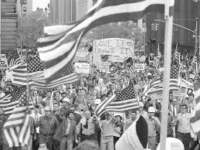
Because I am now committed to doing a blog post a week, I decided to do this week’s on Labor Day and its implications for peacebuilding. Although I didn’t grow up as a red diaper baby as leftist kids of my generation who had leftist parents were known, Pete Seeger, Woody Guthrie, the Almanac Singers, and the like were part of my teenage years. And while I spent a fair amount of time as a student learning about the history of the American left and the labor movement, I’d largely left it behind when I ended up specializing in European politics in grad school and then reconnected with the peacebuilding community in the 1980s.
So, it seemed to make sense to spend a couple of days on the subject over the holiday weekend.
To my surprise, I found myself reaching an intriguing conclusion that could end up shaping some of what we do in the Peacebuilding Starts at Home campaign.
Not Quite a Blank Slate
But first some background.
I did what I always do when I take on a new topic—I ran an Ecosia (rather than Google) search on Labor Day and peace. I got a lot of hits. Few of them, however, told you much. If you run the search for images, you get even less which also explains why this post has fewer pictures than usual.
To be honest, that was what I expected to find given what I learned as a history student. Though I’ve forgotten much of what I learned nearly sixty years ago, two historical trends stand out which led me to the unexpected conclusion that I will turn to in the next section.
The history of the American labor movement and peace advocates is a complicated one that helps explain why I didn’t get very far with a basic internet search. That starts with the symbolically important fact that we celebrate Labor Day in September, not on May 1, which is when most of the rest of the world honors its workers.
There are many reasons why that’s the case, but near the top of any list has to be American aversion to anything that smacks of Marxism. Indeed, that goes back to the late nineteenth century when both the labor movement and the United States government wanted to distance themselves from the socialist left when it adopted Labor Day as a holiday.
We should also note that the labor movement got swept up in the anticommunist movements both before and after World War II. The relevant part of that history for our purposes here is the fact that blue collar workers and their leaders became as patriotic as any group of Americans during the 1950s and 1960s. That, in turn, led to the frequent confrontations between members of the working class and people like me who opposed American involvement in the Viet Nam war as depicted in the photo of the pro-war “hardhat” demonstration at the top of this post..
Looking back at the late 1960s and early 1970s, it is easy to see the beginnings of a trend that has now finds a majority of white working class voters supporting Trump and the Republican Party as Patrick Ruffini and others have documented.

There is, of course, more to the story than the rightward shift of working class voters and the labor movement that was already well underway by the time I learned my first union songs in the early 1960s.
As the working class realigned, its presence in the peace movement and in the peacebuilding organizations like the ones I work with became hard to ignore.
Not just an American phenomenon as Sunday’s state (land) elections in eastern Germany and the rise of the far right in Europe in general attest. Nonetheless, you do find a pacificist and international streak in most European May Day celebrations even if they are featured less than they were I went to them while doing research on the French new left in 1973.
The Challenge Today
That history also points us toward asking a different question. Does the peacebuilding community have anything to offer to the labor movement and/or labor markets in general?
My answer is, potentially yes
As we begin defining what Peacebuilding Starts at Home entails, we will have to make what I’ve taken to calling the peacebuilding pivot. As I’ve pointed out a few times in recent weeks, other issues, like climate change, race, gender, and economy inequality are the ones that capture most people’s attention and sparked the waves of activism we have seen so far in the 20202s—not peacebuilding. More importantly, we will never achieve stable peace unless we make a dent in all of those underlying causes of our ideological divisions and the polarization that comes with them.
A group of peacebuilders and activists interested in some or all of these issues will be meeting at the AfP office (which not coincidentally is in the Service Employees International Union building) to plan what we could do together. Rest assured that the state of the American labor market and economic inequality in particular will be on the agenda.

NEXT TIME: Holding and Enjoy Tough Discussions, Rotary Style
The views and opinions expressed in this article are those of the author and do not necessarily reflect the official policy or position of the Alliance for Peacebuilding or its members.
